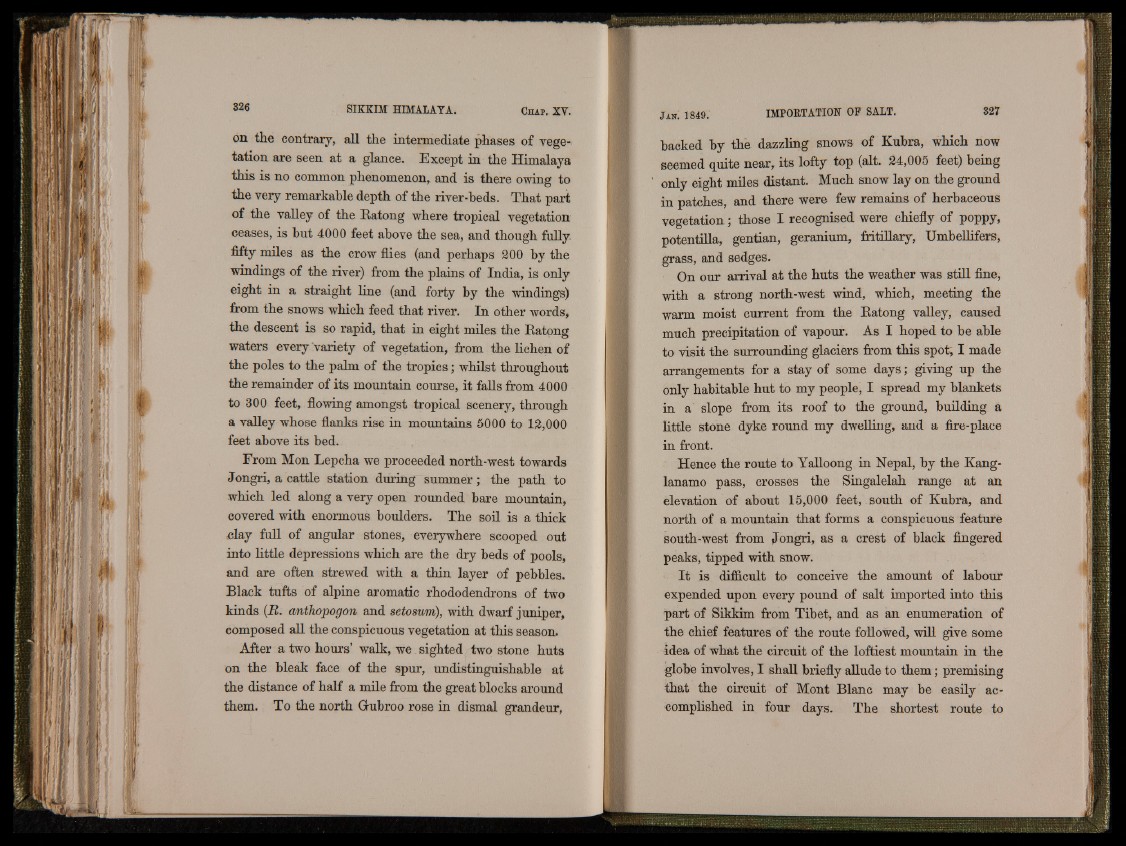
on the contrary, all the intermediate phases of vegetation
are seen at a glance. Except in the Himalaya
this is no common phenomenon, and is there owing to
the very remarkable depth of the river-beds. That part
of the valley of the Ratong where tropical vegetation
ceases, is hut 4000 feet above the sea, and though fully,
fifty miles as the crow flies (and perhaps 200 by the
windings of the river) from the plains of India, is only
eight in a straight line (and forty by the windings)
from the snows which feed that river. In other words,
the descent is so rapid, that in eight miles the Ratong
waters every variety of vegetation, from the lichen of
the poles to the palm of the tropics; whilst throughout
the remainder of its mountain course, it falls from 4000
to 300 feet, flowing amongst tropical scenery, through
a valley whose flanks rise in mountains 5000 to 12,000
feet above its bed.
From Mon Lepcha we proceeded north-west towards
Jongri, a cattle station during summer; the path to
which led along a very open rounded bare mountain,
covered with enormous boulders. The soil is a thick
clay full of angular stones, everywhere scooped out
into little depressions which are the dry beds of pools,
and are often strewed with a thin layer of pebbles.
Black tufts of alpine aromatic rhododendrons of two
kinds (R. anthopogon and setosum), with dwarf juniper,
composed all the conspicuous vegetation at this season.
After a two hours’ walk, we sighted two stone huts
on the bleak face of the spur, undistinguishable at
the distance of half a mile from the great blocks around
them. To the north Gubroo rose in dismal grandeur,
backed by the dazzling snows of Kubra, which now
seemed quite near, its lofty top (alt. 24,005 feet) being
only eight miles distant. Much snow lay on the ground
in patches, and there were few remains of herbaceous
vegetation; those I recognised were chiefly of poppy,
potentilla, gentian, geranium, fritillary, Umbellifers,
grass, and sedges.
On our arrival at the huts the weather was still fine,
with a strong north-west wind, which, meeting the
warm moist current from the Ratong valley, caused
much precipitation of vapour. As I hoped to be able
to visit the surrounding glaciers from this spot; I made
arrangements for a stay of some days; giving up the
only habitable hut to my people, I spread my blankets
in a slope from its roof to the ground, building a
little stone dyke round my dwelling, and a fire-place
in front.
Hence the route to Yalloong in Nepal, by the Kang-
lanamo pass, crosses the Singalelah range at an
elevation of about 15,000 feet, south of Kubra, and
north of a mountain that forms a conspicuous feature
south-west from Jongri, as a crest of black fingered
peaks, tipped with snow.
I t is difficult to conceive the amount of labour
expended upon every pound of salt imported into this
part of Sikkim from Tibet, and as an enumeration of
the chief features of the route followed, will give some
idea of what the circuit of the loftiest mountain in the
globe involves, I shall briefly allude to them; premising
that the circuit of Mont Blanc may be easily accomplished
in four days. The shortest route to